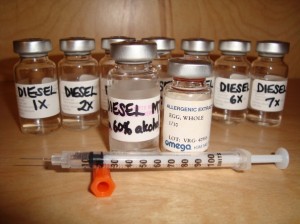Neil McKinney, ND
Naturopathic doctors are aware that symptoms in any system of the human body can be triggered by foods, environmental inhalants and chemicals. We are also cognizant of the severe limitations of allergy tests, such as blood for immunoglobulins and skin prick testing. Food allergies are not reliably detected by skin prick tests. Another way to look at it is that IgE antibodies in the skin do not typically correspond to the biological reaction to foods in the gut. We call non-immune, allergy-like reactions “sensitivities.” We do not know the mechanism by which they occur, and this makes it difficult to arrive at a diagnostic standard.
Many of us use kinesiology muscle testing or electrodermal testing to screen for possible reactants and stressors. One study panned electrodermal testing because it did not correspond well to skin prick test results, but this is hardly a gold standard, and neglects the issue of non-immune sensitivity reactions (Lewith et al., 2001). Other studies have shown a reasonable correspondence of electrodermal testing with skin tests, blood tests and clinically observed reactions to sublingual and subdermal provocation (Tsuei et al., 1984). Electrodermal testing has even been extended to test for organ issues, and to suggest a variety of medical diagnoses (Brewitt, 1996).
When a screening test suggests a short list of offending substances, results may be confirmed by avoidance and reintroduction, or by a standard scientific test. In the case of suspected food triggers, we may prescribe a hypoallergenic diet and, after a few weeks, challenge with one food a day every four days and look for a provocation reaction.
Once we confirm the patient is better without the offending food or chemical and reliably worse on exposure, we can initiate therapy. We can try to cure the underlying allergic and sensitive constitution with classical homeopathy; use alkaline salts, buffered vitamin C and quercetin to squelch reactions; or try to modulate immune function with plant sterols and sterolins, to name just a few current naturopathic strategies.
Once the specific triggering substances are identified, we can usually neutralize the reaction by sublingual administration of homeopathic preparations of the substance. This is particularly indicated where the offending substance is very difficult to avoid, a rotation diet is not practical, and other treatments are deemed too costly or complicated, or just plain fail to work.
One of our colleagues has published an excellent report on a kinesiology and electrodermal method to diagnose sensitivities, along with the electronic imprinting of homeopathic pellets with the frequency of the reactive substance to treat sensitivities (Kail, 2001). The report describes “diagnosis” of reactive substances by muscle testing and electrodermal methods, and demonstrated that they were reasonably consistent. The report also described neutralization of reactions by homeopathic remedies prepared by electronic imprinting of pellets by a machine that purports to store a substance’s digital signature and be able to transfer it to blank lactose/sucrose pellets.
The most common conventional medical method for allergy desensitization is serum shots. They are given over a 2- to 5-year period, and the reported success rate is in the range of 40%-45%. Many doctor visits are required, and there is a serious risk of anaphylactic reactions.
The Miller Method
The Miller method is a rapid desensitization process involving subdermal injection of escalating doses of the reactive substance (Miller, 1997). It has been quite successful in treating conventional inhalant allergies, but is not commonly applied for food and chemical sensitivities. A homeopathic variation of this process has shown itself to be more flexible and clinically reliable.
We start with a standard skin prick allergen solution, such as a 50% glycerin extract. If the substance we want to desensitize is not commercially available, we can make a standard homeopathic mother tincture or trituration in-office. We then make a serial dilution in sterile saline with a phenol preservative. I buy a 9ml standard allergen diluent in a rubber-top glass vial. To this I add 1ml of the allergen solution, and succuss to arrive at a 1X dilution. Some colleagues prefer a 1 in 5 dilution process, but I work with the decimal dilution. I then repeat this process, putting 1ml of the 1X solution into another blank 9ml saline diluent, and with succession arrive at a 2X product, and by reiteration create a series of dilutions from 1X to 7X.
In the early years we would actually test what was the maximum dilution that still provoked a reaction by kinesiology or electrodermal testing. Then we would give the next higher dilution, and after several minutes re-test, and see the sensitivity to the lower dilution clear. Currently we simplify this by starting at the 7X dilution, give 0.10 to 0.15ml under the tongue, hold it there 30 seconds, then swallow, and set a timer for 6 minutes. Next we give the 6X solution, and repeat until we have given the 1X solution. This process takes about 45 minutes. As with all homeopathics, the patient should have no food or drink for about 30 minutes after the last drops are placed under the tongue.
The drops applied to the veins under the tongue carry increasing increments of the allergen challenge into the bloodstream to safely and rapidly condition the body to tolerate that substance.
Up to three reactors can be treated in one visit, and some doctors will even do four at once. I prefer to stick to three unless the fourth is very closely related to one of the other substances. The patient is advised to strictly avoid the allergens for at least 2 days after desensitization and to take as few allergy medications as possible. Anti-histamines are particularly likely to interfere with this desensitization, so we want to avoid them for 48 hours before and after the procedure. If more than one sensitivity is being treated, reintroduce each potential reactor separately to confirm a response to therapy.
There has never been a harsh reaction to this procedure. I have successfully desensitized patients to substances that previously put them in the intensive care unit, such as peanuts and bee venom. However, I know that when we play the odds, eventually the odds bite back. Always keep emergency medicines such as epinephrine and oxygen, and airways at hand, and be sure to have trained staff to assist in the unlikely event of a reaction. The small reactions I have seen over 24 years doing this have always responded to homeopathic Apis mellifica 6CH or Thymuline 9CH, and acupuncture of points GV-26, PC-6 and LI-11.
Children usually take one treatment, and adults sometimes need two treatments to achieve a comfortable tolerance (Scadding and Brostoff, 1986; O’Shea et al., 1981). Significant reduction in sensitivities is achieved in about 80% of cases. This is double the success rate of the standard medical procedures at a fraction of the cost and time. Booster treatments are recommended as needed, usually at one year from the first. Most treatments are durable for years. When boosters are given, it is typically a lot longer period before the next is needed. The desensitization allows more frequent exposure to more of the reactive substance, but does not always stand up to heavy daily exposure. The patient is well advised to continue to minimize exposure, use alternative foods and products, avoid unnecessary exposure to danders, molds, mites, pollens and so forth.
In short, you can in a vast majority of cases reduce sensitivities and allergies to any substance by a homeopathic series of escalating doses sublingually. The cost to the patient is very low, the investment in equipment and supplies is nominal, and every ND has the training to understand and apply this method.
Neil McKinney, ND has more than 23 years of clinical experience. He was a founder of BINM and teaches extensively in naturopathic medicine. He is author of two books on naturopathic oncology, and has a practice focused on integrative cancer care, pain and allergies in Victoria, BC. See
References
Brewitt J: Quantitative analysis of electrical skin conductance in diagnosis: historical and current views of bioelectric medicine, J Naturopathic Med 6(1):66-74, 1996.
Kail: Clinical outcomes of a diagnostic and treatment protocol in allergy/sensitivity patients, Alt Med Rev 6(2):188-202, 2001.
Lewith et al: Is electrodermal testing as effective as skin prick tests for diagnosing allergies? A double-blind, randomized block design Study, Brit Med J 322:131-134, 2001.
Miller JB: Double-blind study of food extract injection therapy, Annals of Allergy 38:185-192, 1997.
O’Shea JA et al: Double-blind study of children with hyperkinetic syndrome treated with multi-allergen extract aublingually, Journal of Learning Disabilities 14(4):189-192, 1981.
Scadding, Brostoff: Low dose sublingual therapy in patients with allergic rhinitis due to house dust mites, Clinical Allergy 16:483-491, 1986.
Tsuei et al: Food allergy study utilizing the EAV acupuncture technique, Amer J Acup 12(2):105-116, 1984.





